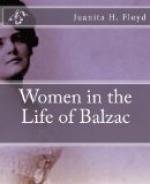Madame Gay was by no means universally beloved. In her sharp and disagreeable voice she said much good of herself and much evil of others. She had a mania for titles and was ever ready to mention some count, baron or marquis. In her drawing-room, Balzac found a direct contrast to the Royalist salon of the beautiful Duchesse de Castries which he frequented. In both salons, he met a society entirely unfamiliar to him, and acquainted himself sufficiently with the conventions of these two spheres to make use of them in his novels.
The Physiologie du Mariage, published anonymously in December, 1829, gave rise to a great deal of discussion. According to Spoelberch de Lovenjoul, two women well advanced in years, Madame Sophie Gay and Madame Hamelin, are supposed to have inspired the work, and even to have dictated some of its anecdotes least flattering to their sex. This Madame Hamelin, born in Guadeloupe about 1776, was the marvel of the Directoire, and several times was sent on secret missions by Napoleon. The role she played under the Directoire, the Consulat and the Empire is not clear, but she was a confidential friend of Chateaubriand, lived in the noted house called the Madeleine, near the forest of Fontainebleau, and wrote about it as did Madame de Sevigne about Les Rochers. While living there, she received her Bonapartist friends as well as her Legitimist friends. Having lived in a society where life means enjoyment, she had many anecdotes to relate. She was a fine equestrienne, a most beautiful dancer, apparently naturally graceful, and bore the sobriquet of la jolie laide. Her marriage to the banker, M. Hamelin, together with her accomplishments, secured her a place in the society of the Directoire. Balzac, in a letter to Madame Hanska, refers to her as une vieille celebrite, and states that she wept over the letter of Madame de Mortsauf to Felix in Le Lys dans la Vallee. It is interesting to note that he later built his famous house and breathed his last in the rue Fortunee to which Madame Hamelin gave her Christian name, since it was cut through her husband’s property, the former Beaujon Park, and that it became in 1851 the rue Balzac.
Delphine Gay, the beautiful and charming daughter of Madame Sophie Gay, was called “the tenth muse” by her friends, who admired the sonorous original verses which she recited as a young girl in her mother’s salon. She became, in June, 1831, the wife of Emile de Girardin, the founder of the Presse. Possessing in her youth, a bellezza folgorante, Madame de Girardin was then in all the splendor of her beauty; her magnificent features, which might have been too pronounced for a young girl, were admirably suited to the woman and harmonized beautifully with her tall and statuesque figure. Sometimes, in the poems of her youth, she spoke as an authority on the subject of “the happiness of being beautiful.” It was not coquetry with her, it was the sentiment of harmony; her beautiful soul was happy in dwelling in a beautiful body.




